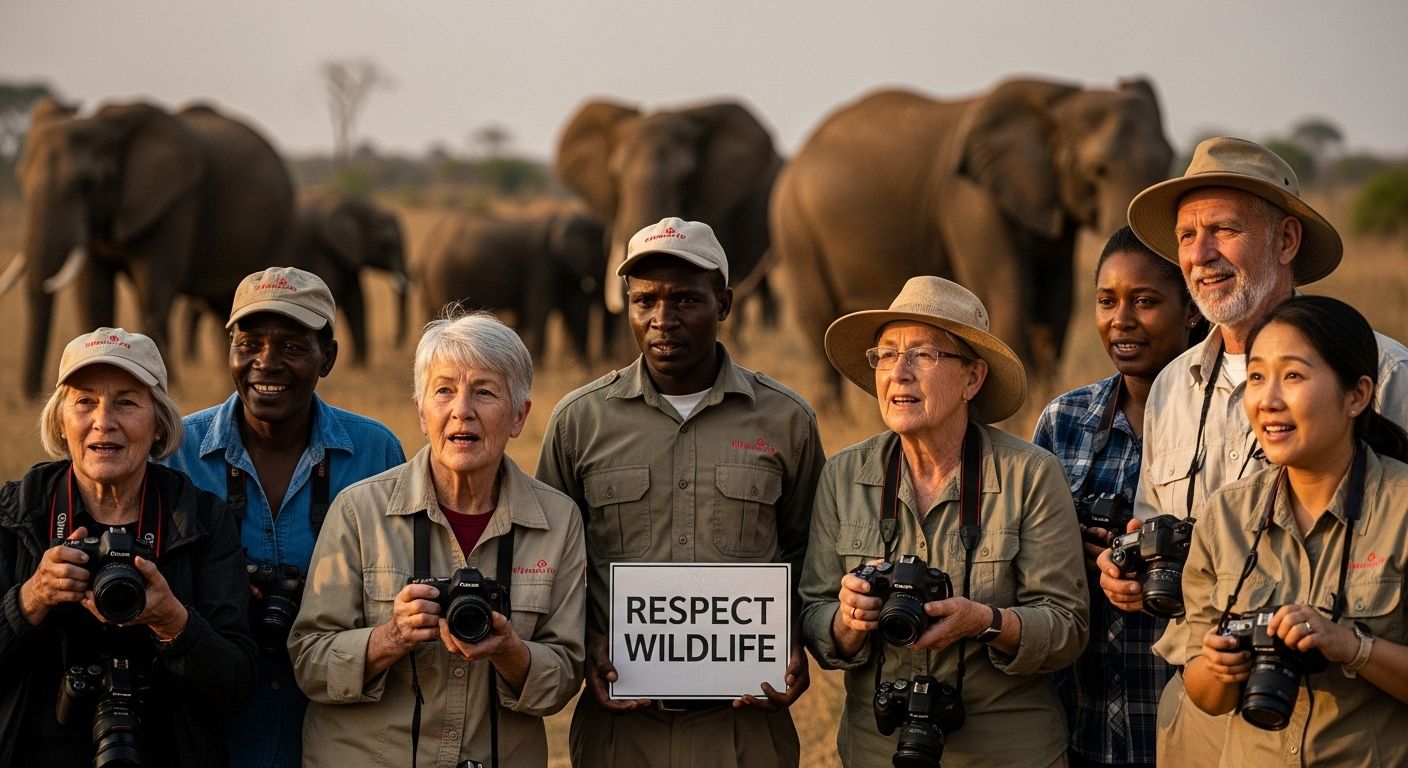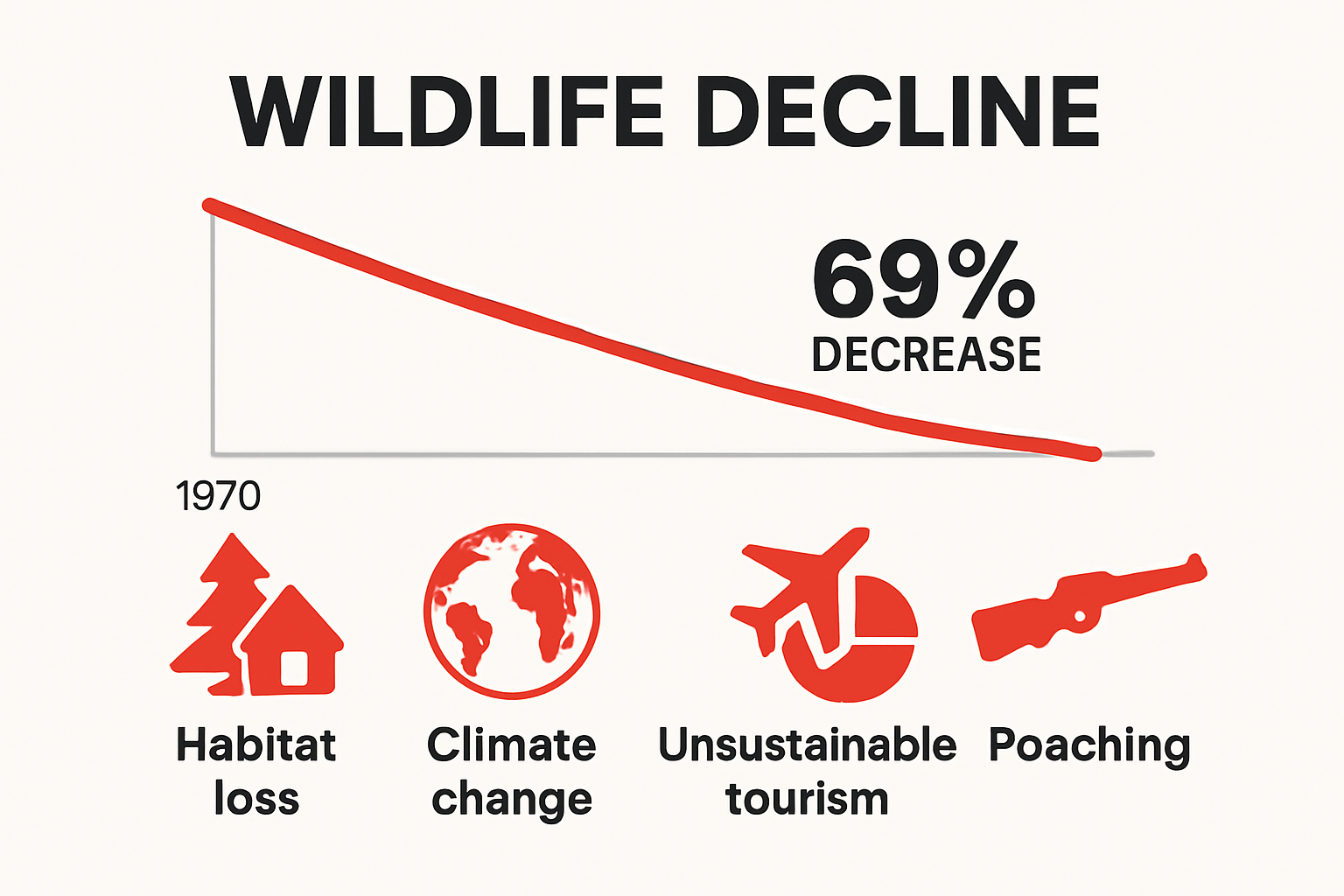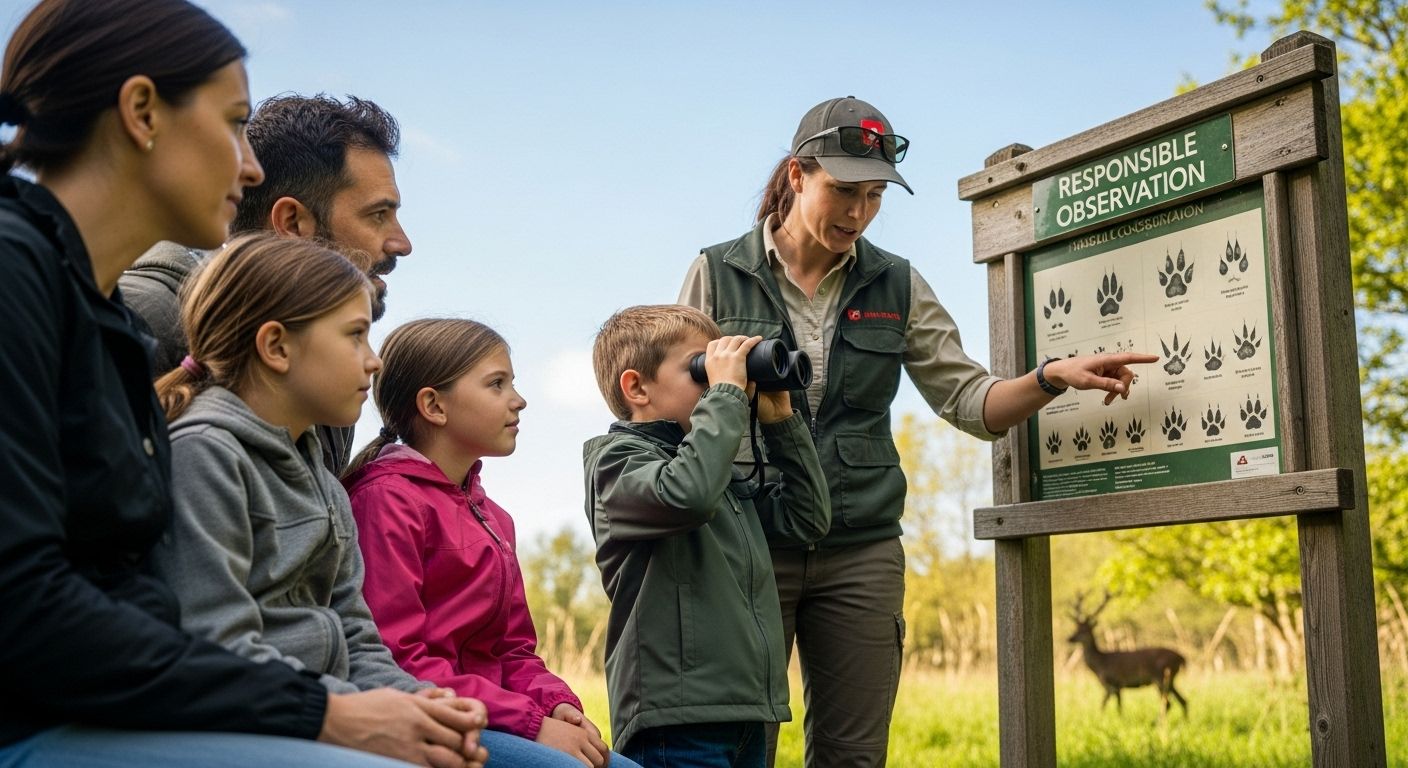How to Respect Wildlife: Essential Tips for Mindful Travel
Full Disclosure: Our AI Assistant Writes These!
While we're out in the bush tracking leopards, dodging elephants, and trying to get the perfect sunset shot, our trusty AI companion is back at camp, diligently crafting these blog posts. Don't worry though - it's been trained on years of real safari experiences and only occasionally suggests that tourists should pet the lions. (Please don't pet the lions. The AI was joking. We hope.)
The real reason? SEO loves fresh content, and we love fresh adventures. So while our AI handles the keywords and search rankings, we're out there finding the next hidden waterhole, secret viewpoint, or that one tree where the leopards always hang out. Win-win, really!
How to Respect Wildlife: Essential Tips for Mindful Travel

Travelling gives you a front-row seat to the wild beauty of nature. Some people believe getting close is the best way to experience African wildlife. But scientists warn that getting too close has real consequences. Global wildlife populations have dropped by about 69% since 1970. There is a better way to connect that leaves the animals’ world intact and your travel moments even richer.
Table of Contents
- Understanding Why Respecting Wildlife Matters
- Practical Ways To Observe Animals Safely
- Responsible Behaviour For Different Travel Styles
- Supporting Conservation On And Off The Road
Quick Summary
| Takeaway | Explanation |
|---|---|
| Respect wildlife as sentient beings | Acknowledge animals’ complex social structures and ecological roles beyond mere entertainment. |
| Maintain safe distances in wildlife observation | Keep a minimum of 50 meters away to prevent stressing animals and disrupting natural behavior. |
| Choose responsible travel operators | Opt for tour providers that prioritize wildlife conservation and community support to ensure sustainable practices. |
| Engage in advocacy for wildlife | Share knowledge about conservation issues and support research to raise awareness on ecological challenges. |
| Commit to ongoing conservation efforts | Practice eco-friendly habits and support local initiatives to contribute to wildlife preservation beyond your travels. |
Understanding Why Respecting Wildlife Matters
Wildlife represents the intricate web of life that sustains our planet’s delicate ecological balance. When travelers engage with wildlife environments, they become direct participants in complex ecosystems that demand profound respect and careful understanding. Respecting wildlife goes far beyond simple observation it involves recognizing the interconnected nature of all living beings and our responsibility to minimize human interference.
The Ecological Significance of Wildlife Preservation
Ecosystems function like sophisticated, interdependent networks where each species plays a crucial role. Research from the World Wildlife Fund reveals that global wildlife populations have declined by approximately 69% since 1970, highlighting the urgent need for conservation efforts. This dramatic reduction occurs due to multiple human-induced factors including habitat destruction, climate change, and unsustainable tourism practices.

By understanding wildlife’s intrinsic value, travelers can transform from passive observers to active conservation supporters. Each wildlife interaction presents an opportunity to learn, appreciate, and contribute to protecting these remarkable creatures and their habitats. The principle of minimal impact becomes paramount ensuring that human presence does not disrupt natural behaviors or cause unnecessary stress to animal populations.
Ethical Considerations in Wildlife Interactions
Respecting wildlife demands a fundamental shift in perspective from viewing animals as entertainment to recognizing them as sentient beings with complex social structures and ecological roles. According to conservation biologists at National Geographic, ethical wildlife interactions involve maintaining safe distances, avoiding direct feeding, and understanding animal communication signals.
Travelers must recognize that wildlife is not a commodity or photographic opportunity but a vital component of global biodiversity. When humans approach wildlife with genuine curiosity, empathy, and reverence, they create meaningful connections that transcend mere tourism. This approach supports sustainable travel practices that prioritize animal welfare and habitat preservation.
Individual Impact and Global Responsibility
Every traveler possesses the power to make significant contributions to wildlife conservation. By choosing responsible tour operators, supporting local conservation initiatives, and educating themselves about specific regional ecosystems, individuals can become powerful advocates for wildlife protection. Learn more about our approach to responsible wildlife tourism.
Understanding why respecting wildlife matters requires acknowledging our interconnectedness with the natural world. It means recognizing that our actions have immediate and long-term consequences for animal populations, their habitats, and the broader environmental systems that sustain life on our planet. Through mindful travel practices, we can transform wildlife encounters from mere experiences into meaningful contributions toward global conservation efforts.
Practical Ways to Observe Animals Safely
Wildlife observation requires a delicate balance between human curiosity and animal preservation. Safely observing wildlife demands more than passive watching it requires active awareness, respect, and strategic approaches that prioritize animal welfare and ecological integrity. The goal is to create meaningful encounters that do not disrupt natural behaviors or cause unnecessary stress to wildlife populations.
Maintaining Appropriate Distances and Visual Boundaries
Research from the Wildlife Conservation Society indicates that maintaining appropriate physical distance is crucial for minimizing animal stress. Professional wildlife guides recommend staying at least 50 meters away from most wild animals, with specific recommendations varying by species and local ecosystem regulations. This distance prevents potential behavioral disruptions and reduces the risk of animals perceiving humans as threats.
Understanding animal body language becomes essential in these interactions. Signs of distress such as raised tails, sudden movement, or changed posture signal that observers have entered an uncomfortable proximity. Professional wildlife photographers and guides train extensively in reading these subtle communication signals, ensuring they can retreat or adjust their position without causing undue anxiety to the animals.
Responsible Observation Techniques
Responsible wildlife observation requires sophisticated strategies that go beyond physical distance. According to National Geographic wildlife experts, successful and ethical wildlife watching involves multiple considerations:
- Silent Observation: Minimizing noise and sudden movements prevents startling animals and interrupting their natural behaviors.
- Using Appropriate Equipment: Utilizing long-range binoculars and telephoto camera lenses allows detailed observation without physical proximity.
- Understanding Local Ecosystem Rules: Each wildlife environment has unique guidelines that protect both animals and visitors.
Professional wildlife guides emphasize the importance of patience. Quick movements, loud noises, and attempts to attract animal attention can fundamentally disrupt natural behaviors. Learn more about our expert safari observation techniques.
Technology and Educational Tools for Ethical Wildlife Watching
Modern technology offers innovative solutions for safe and respectful wildlife observation. Advanced tracking applications, guided virtual tours, and educational resources provide alternative methods for experiencing wildlife without direct physical interaction. These tools not only protect animals but also offer deeper educational insights into their behaviors, habitats, and conservation challenges.
Technology enables travelers to become informed observers rather than invasive visitors. Smartphone applications can provide real-time information about animal behaviors, migration patterns, and local conservation efforts. By leveraging these digital resources, travelers transform their wildlife encounters from mere visual experiences to meaningful learning opportunities.
Observing wildlife safely is an art that combines scientific understanding, technological innovation, and genuine respect for natural ecosystems. It requires travelers to approach wildlife encounters with humility, curiosity, and a commitment to minimal environmental impact. Through mindful observation techniques, we can create profound connections with wildlife while ensuring their continued survival and well-being.
Below is a summary of practical tips for observing wildlife safely. This checklist organises recommended behaviours, equipment, and actions for ethical and low-impact wildlife observation, as described in the article.
| Practice/Technique | Recommended? |
|---|---|
| Maintain minimum distance (50m) | Yes |
| Stay silent (avoid loud noises) | Yes |
| Use binoculars/telephoto lens | Yes |
| Move slowly and patiently | Yes |
| Feed or touch wildlife | No |
| Learn animal body language | Yes |
| Follow local ecosystem rules | Yes |
Responsible Behaviour for Different Travel Styles
Responsible wildlife interaction transcends a one-size-fits-all approach. Different travel styles demand nuanced strategies for minimizing environmental impact and respecting animal habitats. Whether traveling solo, as a family, in luxury groups, or on budget adventures, travelers must adapt their approach to wildlife encounters with thoughtful consideration and cultural sensitivity.
Solo and Adventure Travelers
Research from the Responsible Tourism Partnership indicates that solo travelers often have greater flexibility in making ethical wildlife observation choices. These travelers can more easily follow strict guidelines, move quietly, and minimize disruptions to natural environments. Adventure travelers specifically must develop a heightened awareness of their surroundings and potential ecological impacts.
Key considerations for solo wildlife enthusiasts include choosing small group tours with experienced local guides, using minimal equipment, and maintaining strict personal discipline around wildlife interaction protocols. The ability to move silently and observe without creating significant disturbance becomes a critical skill. Learn more about cultural sensitivity in wildlife tourism.
Family and Group Travel Strategies
According to ecotourism experts at the International Ecotourism Society, family and group travel requires additional layers of preparation and education. Children and larger groups naturally generate more noise and movement, which can potentially stress wildlife. Successful responsible behavior involves comprehensive pre-trip education about wildlife ecosystems, communication strategies, and age-appropriate understanding of conservation principles.
Effective family wildlife experiences involve:
- Preparatory Education: Teaching children about animal behaviors and observation etiquette.
- Structured Observation: Using guided tours with professional naturalists.
- Interactive Learning: Engaging with conservation-focused activities that create meaningful connections.
Parents and group leaders play a crucial role in modeling respectful wildlife interaction, transforming potential disruptions into educational opportunities that inspire future conservation advocates.
Luxury and Budget Travel Considerations
Regardless of travel budget, responsible wildlife observation remains consistent. Luxury travelers might access more exclusive experiences, while budget travelers navigate more communal environments. Both require identical fundamental principles of minimal interference and maximum respect.
Luxury travel often provides access to specialized guides and private conservation areas, offering deeper insights into wildlife preservation. Budget travelers can contribute equally through careful selection of ethical tour operators, community-based tourism initiatives, and personal commitment to responsible practices.
The core principle remains universal: wildlife observation is a privilege, not an entitlement. Every traveler, regardless of their style or budget, carries the responsibility of preserving natural habitats and supporting local conservation efforts. By approaching wildlife encounters with genuine respect, curiosity, and humility, travelers can create meaningful experiences that benefit both human visitors and animal populations.
Understanding that responsible behavior is not about restrictions but about creating harmonious interactions transforms wildlife tourism from a passive experience into an active contribution to global conservation efforts. Each traveler becomes a potential ambassador for wildlife protection, capable of making significant positive impacts through mindful, informed, and respectful engagement with natural environments.
To help travellers of all backgrounds adopt eco-friendly practices, here’s a comparison of responsible wildlife travel behaviours by travel style. This table summarises strategies for solo, family, and luxury/budget travel, drawing on tips outlined in the article.
| Travel Style | Key Behaviours | Special Considerations |
|---|---|---|
| Solo & Adventure | Follow strict guidelines, observe quietly, maintain discipline | Greater flexibility; can minimise disruptions |
| Family & Group | Educate beforehand, use guided tours, model respectful behaviour | Prepare children; pre-trip learning essential |
| Luxury | Use specialised guides, support conservation projects | More exclusive access; deepen conservation impact |
| Budget | Choose ethical operators, support local communities | Participate in community-based tourism |
Supporting Conservation On and Off the Road
Conservation is a continuous journey that extends far beyond momentary wildlife encounters. Travelers possess unique opportunities to contribute meaningfully to wildlife preservation through strategic actions both during their travels and in their everyday lives. The most impactful conservation efforts emerge from understanding interconnected ecosystems and recognizing individual potential for creating substantial environmental change.
Direct Financial and Community Support
Research from the World Wildlife Fund demonstrates that targeted financial contributions can significantly impact wildlife preservation efforts. Travelers can directly support conservation by choosing tour operators and accommodations that allocate a percentage of their revenues to local conservation projects. These contributions fund critical research, habitat protection, and community education initiatives that create sustainable environmental protection strategies.
Supporting local communities becomes paramount in conservation efforts. When travelers invest in community-based tourism models, they create economic incentives for local populations to protect wildlife habitats. This approach transforms conservation from an external intervention into a collaborative, mutually beneficial process. Local communities become active stewards of their natural environments, developing economic models that prioritize ecological preservation.
Advocacy and Educational Engagement
According to conservation experts at National Geographic, effective conservation requires robust public awareness and engagement. Travelers can become powerful advocates by sharing their experiences, supporting scientific research, and raising global consciousness about wildlife preservation challenges. This involves more than social media posts it requires genuine commitment to spreading nuanced, fact-based information about ecological systems.
Strategic advocacy includes:
- Social Media Education: Sharing accurate, research-backed information about wildlife conservation.
- Supporting Research Initiatives: Contributing to scientific projects that track wildlife populations and behaviors.
- Promoting Ethical Tourism: Encouraging fellow travelers to adopt responsible wildlife interaction practices.
Learn more about our comprehensive wildlife conservation approaches.
Long-Term Commitment and Personal Transformation
True conservation support transcends transient tourist experiences. It requires a fundamental reimagining of human relationships with natural environments. Travelers can maintain their conservation commitment through continued learning, supporting conservation organizations, and making lifestyle choices that reduce environmental impact.
Personal transformation involves understanding that every individual action contributes to broader ecological systems. Practical steps include reducing plastic consumption, supporting sustainable brands, participating in local conservation programs, and maintaining an ongoing educational commitment to understanding global biodiversity challenges.
Supporting conservation represents a holistic approach to environmental stewardship. It combines immediate actions during travel with sustained commitment to protecting global ecosystems. By recognizing the intricate connections between human activities and wildlife preservation, travelers can transform their journeys into meaningful contributions toward global environmental sustainability. Each conscious choice becomes a powerful statement of respect for the complex, interconnected web of life that sustains our planet.

Frequently Asked Questions
What are the key principles of respecting wildlife during travel?
The key principles include acknowledging wildlife as sentient beings, maintaining safe distances, choosing responsible travel operators, engaging in advocacy, and committing to ongoing conservation efforts.
How far should I stay from wild animals while observing them?
It is recommended to maintain a minimum distance of 50 meters from most wild animals to prevent stressing them and disrupting their natural behavior.
What should I do if I see wildlife while hiking or exploring?
When encountering wildlife, remain silent, keep a safe distance, and avoid sudden movements. Use binoculars or a telephoto lens for observation without getting too close.
How can technology aid in responsible wildlife observation?
Technology can provide tracking applications, guided virtual tours, and educational resources that allow travelers to observe wildlife ethically while learning about their behaviors and conservation challenges.
Turn Your Wildlife Respect Into an Unforgettable African Journey
You have just seen how powerful mindful travel can be. The article highlighted real challenges facing wildlife, like population decline and the stress caused by human interference. You want to do more than simply observe from a distance you want to make your safari experience meaningful and responsible. At Africa Awesome, your values meet our expertise. We design safaris where respecting animal habitats, choosing ethical guides, and learning from the land are built into every step. You can make your passion for conservation part of your adventure.

Take the next step. Explore our tailored safari experiences built for those who want to protect what they discover. Speak with local travel experts, customise your wildlife-friendly itinerary, and enjoy peace of mind with secure booking and flexible payment options. Let your journey leave a positive impact. Discover more about planning a mindful African safari at Africa Awesome and start turning thoughtful travel into real change today.
Recommended
-
Responsible Diving Tips for Eco-Friendly Divers - The Cenote Guy
-
[
Dog Safety Outdoors: Essential Tips for 2025
– iPupPee](https://ipuppee.com/blogs/news/dog-safety-outdoors-essential-tips-2025)